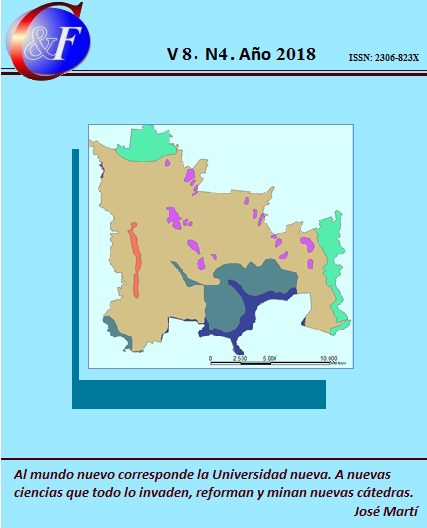Thermal effect of submerged arc welding on API 5L x42 steel
Keywords:
micro-alloyed steel, microstructure, pipeline, flux, hardness.Abstract
The microstructural performance of a low alloy steel API 5L X42 used in pipeline, welded through the submerged arc welding process (SAW) was established. The welding was done at the top with preparation of the edges at 30°, in a pipe with a diameter of 250 mm; the filler material used was F48 A0-EL-12 with agglomerated flux H-400. The microstructural analysis was carried out in the molten zone, in the interface and the thermal influence zone; where the fine grain phases of the troostitic type and coarse grain with ferrite network and the molten zone of the base metal, ferrite of structure Widmanstátten, were obtained. When determining the hardness profiles, it is obtained that this one is 163.8 HV with the base metal, which increases to 207.6 HV in the molten zone.Downloads
References
ANSI, C. C. AWS D1. 1/2000. 2000. Publicaciones AWS, USA.
ASTM E3-95. 2001. Standard Practice for Preparation of Metallographic Specimens. ASTM International, West Conshohocken, PA.
ASTM A262-15. 2015. Standard Practices for Detecting Susceptibility to Intergranular Attack in Austenitic Stainless Steels. ASTM International, West Conshohocken, PA.
BATISTA-SÁNCHEZ, W. 2015. Efecto térmico de la soldadura por arco sumergido en un acero bajo aleado. Tesis de grado. Instituto Superior Minero Metalúrgico de Moa.
BANG, I.; SON, Y.; OH, K.; KIN, Y. & KIM, W. 2002. Numerical simulation of sleeve repair welding of in-service gas pipelines. Welding Research Supplement, Welding Journal 34(12): 273-282.
CISILINO, A.; CHAPETTI, M. & OTEGUI, J. 2000. Minimum thickness for circumferential sleeve repair fillet welds in corroded gas pipelines. International Journal of Pressure Vessel and Piping 79(12): 67-76.
ISHIKAWA, N.; SHINMIYA, T. & IGI, S. 2006. Toughness evaluation on seam HAZ of high strength line pipe. International Journal of Fracture 23(3): 23-32.
JANG-BOG, J. & KWON, D. 2002. The effect of microestructural change on fracture behavior in heat-affected zone of API 5L pipeline steel. International Journal of Fracture 12(2): 10-18.
NOLAN, D.; STERJOVSKI, Z. & DUNNE, D. 2005. Hardness prediction models based on HAZ simulation for in – service welded pipeline steels. Science and Technology of Welding and Joining 6(10): 681-694.
ODDY, A. & MCDILL, J. 1999. Burn through prediction in pipeline welding. International Journal of Fracture 97(4): 249-261.
YU-ICHI, K. 2008. Overview of recent Welding technology relating to pipeline construction. Transactions of JWRI 37(1): 1-5.
Published
How to Cite
Issue
Section
Esta obra está bajo una Licencia Creative Commons Reconocimiento-NoComercial 4.0 Internacional
La Revista Ciencia & Futuro es una revista de acceso abierto, todo el contenido está disponible gratuitamente sin cargo para el usuario o su institución. Los usuarios pueden leer, descargar, copiar, distribuir, imprimir, buscar o vincular los textos completos de los artículos, o utilizarlos para cualquier otro fin lícito, sin pedir permiso previo al editor o al autor. Todo lo anterior, de acuerdo con la definición de BOAI de acceso abierto.
Los autores que publican en esta revista están de acuerdo con los siguientes términos: Licencia Creative Commons Atribución-NoComercial permite que el beneficiario de la licencia tenga el derecho de copiar, distribuir, exhibir y representar la obra y hacer obras derivadas para fines no comerciales siempre y cuando reconozca y cite la obra de la forma especificada por el autor o el licenciante. Los autores pueden establecer por separado acuerdos adicionales para la distribución no exclusiva de la versión de la obra publicada en la revista (por ejemplo, situarlo en un repositorio institucional o publicarlo en un libro), con un reconocimiento de su publicación inicial en esta revista. Se permite y se anima a los autores a difundir sus trabajos electrónicamente (por ejemplo, en repositorios institucionales o en su propio sitio web) antes y durante el proceso de envío, ya que puede dar lugar a intercambios productivos, así como a una citación más temprana y mayor de los trabajos publicados (Véase The Effect of Open Access) (en inglés). Lo anterior debe realizarse siempre sobre el artículo ya publicado por Ciencia & Futuro.
Los autores mantienen el control sobre la integridad de sus trabajos y el derecho a ser adecuadamente reconocidos y citados.
A los editores se les otorgan derechos no exclusivos para publicar y distribuir.



